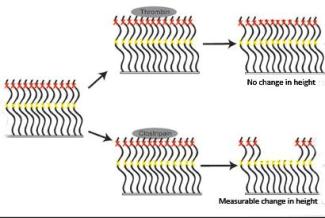Oct 15 2014
A new class of protein-based, smart materials has been created by researchers at the University of California, Berkeley.
These materials could help develop new kinds of drug release systems, flow valves, biological sensors and sensitive, flexible coatings that can manufactured at low-cost on an industrial scale.
 The height of the new protein brush, made from the neurofilament-derived proteins, can be precisely controlled with protein-digesting enzymes, or proteases. The protease thrombin, shown at the top, cut the brush superficially at the red cross marks, resulting in a negligible change to the height of the brush. The protease clostripain cut the brush much more deeply at the yellow cross marks and thus had a more measurable effect on height. Credit: Schematic by Sanjay Kumar
The height of the new protein brush, made from the neurofilament-derived proteins, can be precisely controlled with protein-digesting enzymes, or proteases. The protease thrombin, shown at the top, cut the brush superficially at the red cross marks, resulting in a negligible change to the height of the brush. The protease clostripain cut the brush much more deeply at the yellow cross marks and thus had a more measurable effect on height. Credit: Schematic by Sanjay Kumar
Materials science, synthetic biology and biomolecular engineering have been applied in this development. The networks that are in living cells have inspired creation of these materials.
Typical synthetic coatings, which are also known as polymer brushes are used in many products to prevent clumping of small particles. The research team wanted to create the biological form of the synthetic coatings.
Nerve cells have neurofilaments, which are pipe cleaner-shaped proteins. The neurofilaments collectively form a structural network and act as cylindrical polymer brushes. The neurofilaments maintain their ability to conduct electrical signals by keeping one end of their cell open.
Neurofilaments are intrinsically disordered proteins as they do not have a specific 3-D shape. Their chemical sequence and size can also be easily controlled.
Accuracy in protein synthesis is very important, as the same sequence happens every time. The biochemical order, as well as, the length of the sequence affects the binding ability, structure and all other properties.
Further, the ability to catalyze biochemical reactions is also affected. However, chemical synthesis in the laboratories cannot help achieve such precision demonstrated by the proteins.
The resulting 'protein brush' that was developed had additional properties apart from the normal properties of synthetic brushes. The researchers achieved precise control of the exact length as well as the sequence of the protein brush bristles.
Further, they demonstrated grafting of the protein brushes onto surfaces, and their reaction to modifications in salinity and acidity. This sensitivity to environmental changes and the ability to respond to particular stimuli makes these materials to be considered as "smart" materials.
This study has been published in the Nature Communications journal.